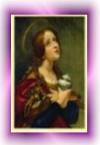son of Saint Magnus of Avignon, who as a layman, served in the French Senate and,
upon the death of his wife, became a monk and eventually a bishop.
Agricolus took his monastic professions at Lérins at the tender age of 16. When he was
32, his father, Bishop of Avignon, appointed him his coadjutor, or assistant. And at his
father’s death in 660, Agricolus succeeded him as Bishop of Avignon. Dedicated to the
life of the Church and its visible presence in the world, he led the construction of a great
church in Avignon in which the monks of Lérins could minister to the community. He
also founded a Benedictine convent.
According to his contemporary, Saint Gregory of Tours, he was characterized by his
great simplicity and spirit of self-denial. He never sat at the table for a meal, but rather
fasted all day until the evening, when he took what little nourishment he allowed himself
standing. Out of devotion to the faithful he served, Agricola expended his resources
enlarging the churches in his diocese and adorning them, particularly with marble and
mosaics.
In 879, the year in which Agricola's body was moved to a new location within the same
church, a man who had been blind for ten years experienced a recurrent dream in which
he was exhorted to go to the tomb of Agricola to obtain a miraculous cure. The man set
out for the church, bringing as a votive offering a small quantity of wax. On the way, he
began to recover his eyesight, which was fully restored by the time he reached the
tomb. Thereafter he spent three days offering thanksgiving for this miracle.
Great miracles, while he was alive, can be attributed to his prayers. During an
infestation of storks, a simple blessing seemed to drive the giant birds away.
He is the patron saint against misfortune, against plague epidemics, for
rain, for good weather, storks.

